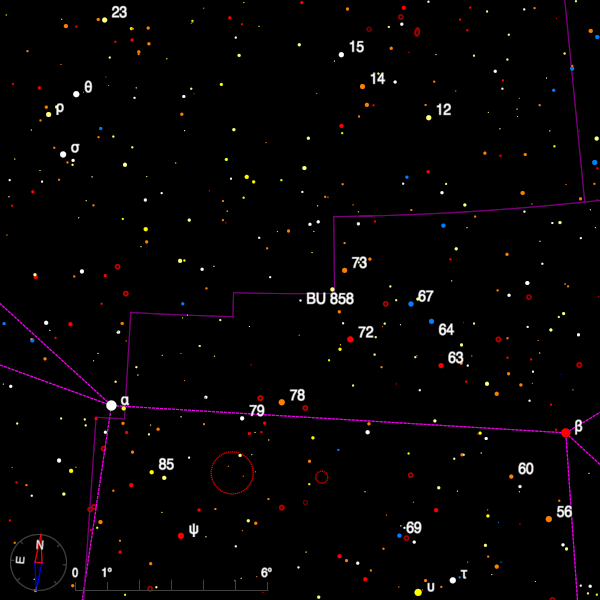October 2020 - Double Star of the Month
In this column exactly 10 years ago, the fine binary star 72 Peg was described. It remains a severe test for 20-cm aperture but as the stars are almost equally bright at V=6, so separating the components, which are now 0".59 apart, is made somewhat easier.
About 2 degrees to the north-east is another Burnham discovery, BU 858 (23 41 17.6 +32 33 40), somewhat wider than BU 720 (BU 858 is 0".8 at present) but with components whose V magnitudes are 7.8 and 8.8 this is an equally challenging pair.

Since discovery in 1881 the companion has moved almost 60 degrees in position angle, but there is no orbit as yet. A magnitude 12.9 star at 23" is being left behind by AB and was also found by Burnham (BU 389) but earlier in his career and with the famous 6-inch refractor. Gaia DR2 does not give data on A and B but quotes a parallax for both stars of 6.66 mas, equivalent to 490 light-years. The faint star is much more distant and clearly optical.
The second edition of the Cambridge Double Star Atlas notes that tau Aqr is preceded, about 45 minutes to the south-west, by a somewhat fainter but still naked-eye star called 69 Aqr (22 47 42.7 -14 03 23). The SIMBAD catalogue also lists alternative names for tau and 69 as tau 2 and tau 1. Tau is unmistakeable - it a magnitude 4.0 star with a distinctly reddish hue - an MO giant in fact.

The closer pair, of which 69 Aqr is the brighter component, are separated by about 20" but this distance has been closing since 1781 when William Herschel found the stars 35".8 apart. Measures I made in 1994 and 2005 show the distance decreasing over that time interval. This is purely down to difference in proper motions as the stars are at significantly different distances. The pair is also known as STF 2943. The WDS notes that A is also a spectroscopic binary and a putative faint and distant companion found in 1918 does not exist. Herschel noted colours of reddish-white and dusky. A is a hot blue dwarf of spectral type B9 and the companion has a somewhat later spectral type, but Simbad does not elaborate.
Bob Argyle - Double Star Section Director